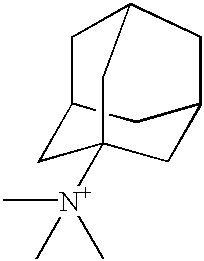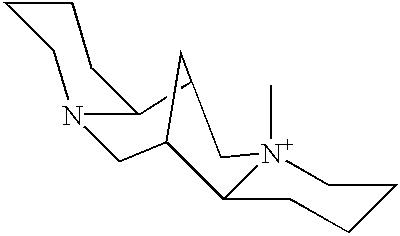Synthesis of porous crystalline materials in fluoride media
a technology of porous crystalline materials and fluoride media, which is applied in the direction of molecular-sieve silica-polymorphs, silicon oxides, silicon compounds, etc., can solve the problems of unsuitable commercial production, undesirable materials, and the addition of these elements
- Summary
- Abstract
- Description
- Claims
- Application Information
AI Technical Summary
Benefits of technology
Problems solved by technology
Method used
Image
Examples
example 2
Synthesis of EMM-1
The process of Example 1 was repeated except that 51.4 mg of H.sub.3 BO.sub.3 and 200 mg of the product of Example 1, as seeds, were added to the synthesis mixture. The mixture had initial pH of 9.7 and the following molar composition:
0.35 GeO.sub.2 :1.0 SiO.sub.2 :0.01H.sub.3 BO.sub.3 :0.2 Hexamethonium dihydroxide:0.4 HF:7.5H.sub.2 O.
The crystallization was carried out for 14 days. The final pH was 9.0 and 8.41 g of white product was obtained. The product had the X-ray diffraction pattern of FIG. 1(b) which, by comparison with the pattern in FIG. 1(a), showed the material to be a mixture of EMM-1 and ITQ-13.
example 3
Synthesis of EMM-1
The process of Example 2 was repeated except that 103 mg of H.sub.3 BO.sub.3 were used instead of the 51.4 mg H.sub.3 BO.sub.3 used in Example 2. The mixture had an initial pH of 9.5 and the following molar composition:
0.35 GeO.sub.2 :1.0 SiO.sub.2 :0.02H.sub.3 BO.sub.3 :0.2 Hexamethonium dihydroxide:0.4 HF:7.5H.sub.2 O.
The crystallization was carried out for 14 days. The final pH was 8.8 and 8.57 g of white product were obtained. The product had the X-ray diffraction pattern of FIG. 1(c) which, by comparison with the patterns in FIGS. 1(a) and (b), indicates the material to be a mixture of EMM-1 with a predominant amount of ITQ-13.
example 4
Synthesis of EMM-1
10.00 g Syton HT-50 silica (Aldrich), 3.05 g germanium oxide (Aldrich), 51.4 mg H.sub.3 BO.sub.3, 7.17 g Hexamethonium (54.9 wt. % Sachem), 200 mg product of Example 1 (seeds), 1.53 g H.sub.2 O, and 2.60 g HF (48 wt % hydrofluoric acid, Aldrich) were added to a 1 oz PFA bottle and shaken for 30 minutes to give a thin, white solution with a little solids settling to the bottom. The pH of the mixture was 9.0 and the mixture had the following molar composition:
0.35 GeO.sub.2 :1.0 SiO.sub.2 :0.01H.sub.3 BO.sub.3 :0.2 Hexamethonium dihydroxide:0.75 HF:7.5H.sub.2 O.
Thus the molar ratio of HF / base (Hexamethonium dihydroxide) was 1.87:1. The bottle was placed in a 300 mL autoclave and heated for 14 days at 150.degree. C. The final pH was 8.0. After washing, filtration, and drying to constant weight under an IR lamp there were obtained 8.61 g of a white solid. The solid had the X-ray diffraction pattern of FIG. 2(a) demonstrating the material to be pure EMM-1.
PUM
| Property | Measurement | Unit |
|---|---|---|
| temperature | aaaaa | aaaaa |
| temperature | aaaaa | aaaaa |
| molar ratio | aaaaa | aaaaa |
Abstract
Description
Claims
Application Information
 Login to View More
Login to View More - R&D
- Intellectual Property
- Life Sciences
- Materials
- Tech Scout
- Unparalleled Data Quality
- Higher Quality Content
- 60% Fewer Hallucinations
Browse by: Latest US Patents, China's latest patents, Technical Efficacy Thesaurus, Application Domain, Technology Topic, Popular Technical Reports.
© 2025 PatSnap. All rights reserved.Legal|Privacy policy|Modern Slavery Act Transparency Statement|Sitemap|About US| Contact US: help@patsnap.com



